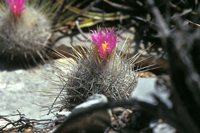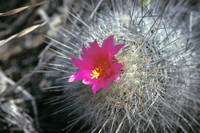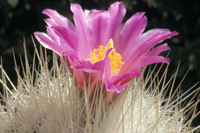Basionym: Echinocactus macdowellii Rebut ex Quehl ('Mc. Dowellii'), Monatsschr. Kakt.-Kunde 4: 133-134 (1894).
Neotype: 33 km northeast of Saltillo on hy. 40 to Monterrey, Coahuila, Mexico, 22 July 1972, Edward F. Anderson 3182 (US 3047870), E.F. Anderson, Bradleya 5: 64 (1987).
Synonyms: Echinomastus macdowellii Br. & R., Cact. 3: 151 (1922). Neolloydia macdowellii H. E. Moore, Baileya 19: 166 (1975). Thelocactus conothelos var. macdowellii Glass & Foster ('mcdowellii'), Cact. Succ. J. (US) 49: 220 (1977). Thelocactus conothelos ssp. macdowellii var. sniceri Halda & Sladkovsky, Acta Mus. Richnov. Sect. natur. 7: 38 (2000). Thelomastus Mac Dowellii Frič, in Kreuzinger, Verzeichnis 10 (1935), nom. illeg.
Description
Stem single, globose, 4-10 cm tall, 4.5-12 cm wide. Ribs indistinct. Tubercles conical. Areoles without glands. Central spines 2-4, 10-50 mm long, white to greyish, straight, acicular. Radial spines 15-25, 8-20 mm long, white, straight, acicular. Flowers 40-80 mm wide, magenta. Seeds 2 x 1.4 mm, testa cells convex with a verrucose surface sculpture.
Distribution
Mexico, Coahuila and Nuevo León, restricted to a small area east of Saltillo, occurring in matorral xerofilo on limestone hills, at elevations of about 1300 to 1600 metres above sea level. Its range lies within the Central Chihuahuan subregion of the Chihuahuan Desert ecoregion.
Risk assessment
Thelocactus macdowellii is placed in the category A (threatened) of the Norma Oficial Mexicana NOM-059-SEMARNAT-2010.
Comments
It is a rather common plant in collections, very much appreciated for its tight, dense and white spination. It is not so common in the wild, indeed only a few localities are known, between Saltillo and Monterrey. The stem is globose, completely divided into tubercles, with areoles bearing twenty or more white spines. The magenta flowers, of a lighter or darker hue, open between February and March. It may be confused with Thelocactus conothelos ssp. argenteus, from which it differs for the absence of areolar glands, the flower morphology and the micro-morphology of the seeds, which have convex testa cells and granular cuticle.
Thelocactus macdowellii (Rebut ex Quehl) C. Glass, Cact. Suc. Mex. 14: 4 (1969).
 The neotype of Echinocactus macdowellii Rebut ex Quehl
The neotype of Echinocactus macdowellii Rebut ex Quehl
33 km northeast of Saltillo on hy. 40 to Monterrey, Coahuila, Mexico, 22 July 1972, Edward F. Anderson 3182 (US 3047870).
Image courtesy CONABIO.
enlarge
 Thelocactus macdowellii
Thelocactus macdowellii
Ojo Caliente, Coahuila
Photo: A. Mosco
enlarge
 Thelocactus macdowellii
Thelocactus macdowellii
Ojo Caliente, Coahuila
Photo: A. Mosco
enlarge
 Thelocactus macdowellii
Thelocactus macdowellii
CSD 192 Arteaga, Coahuila
Photo: A. Mosco
enlarge